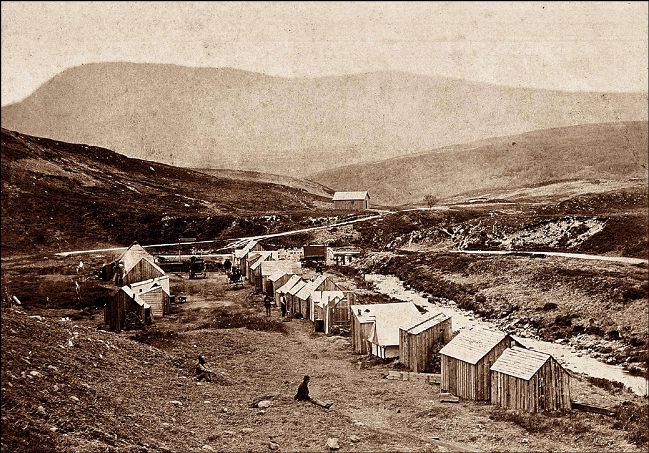 In 1869 the Strath of Kildonan, near Helmsdale in Sutherland, was the scene of a little known gold rush. Baile an Or was the name given to a small community of temporary huts and tents erected by the prospectors.
In 1869 the Strath of Kildonan, near Helmsdale in Sutherland, was the scene of a little known gold rush. Baile an Or was the name given to a small community of temporary huts and tents erected by the prospectors.
This photograph was taken by Alexander Johnston, who worked from Wick, when he visited the site in spring of 1869.
Robert Nelson Gilchrist had returned to his native village in the latter part of 1868 having spent some years prospecting for gold in Australia. He was probably aware that gold had been panned from tributaries of the Helmsdale River in the past although this had not been pursued to any extent.
The story goes that he found gold on his very first day which encouraged him to prospect many of the burns feeding the main river through the Strath, and the Kildonan and Suisgill burns appeared to be the most promising. News of Gilchrist’s success soon spread in Helmsdale and the surrounding areas, and locals who had little prospect of an income during the winter months and whose families were facing starvation, could not resist the opportunity of making at least a few shillings from panning for gold.
The new year saw the number of miners slowly increasing and although many camped out on the hillsides above the burns, some of the more enterprising brought materials with them to build huts which were erected on the flats close to the road from Helmsdale to Kinbrace.
By March 1869, the number of prospectors in the Strath had risen to almost 500 and gold was being bought by local goldsmiths for making rings and other items of jewellery.
The Duke of Sutherland was clearly under some pressure to introduce some regulation into the activities taking place in the Strath. During March 1869 plans were made to charge all the prospectors a licence fee of £1 per month, and for the ‘Revenue’ to levy a 10% Crown duty on all gold finds. These were introduced on 1st April.
Following the bad weather of the early part of the year, spring time brought better conditions for the diggers and work on three local burns – the Kildonan, Suisgill and Torish. At Kildonan a settlement of tents and wooden huts was erected on the open space adjacent to the road bridge over the Kildonan burn, and was called Baile an Or – Town of Gold.
The Duke was not to be persuaded that much good would derive from the continuation of the diggings and towards the end of December 1869 the inevitable announcement was made that no new licences would be issued in the New Year. Early in January 1870 the huts were burned and the ground was cleared.
Abridged from the Baile An Or Project website.
The full story is told in the book British Mining No 84 – The Scottish Gold Rush of 1869
Return to previous page
